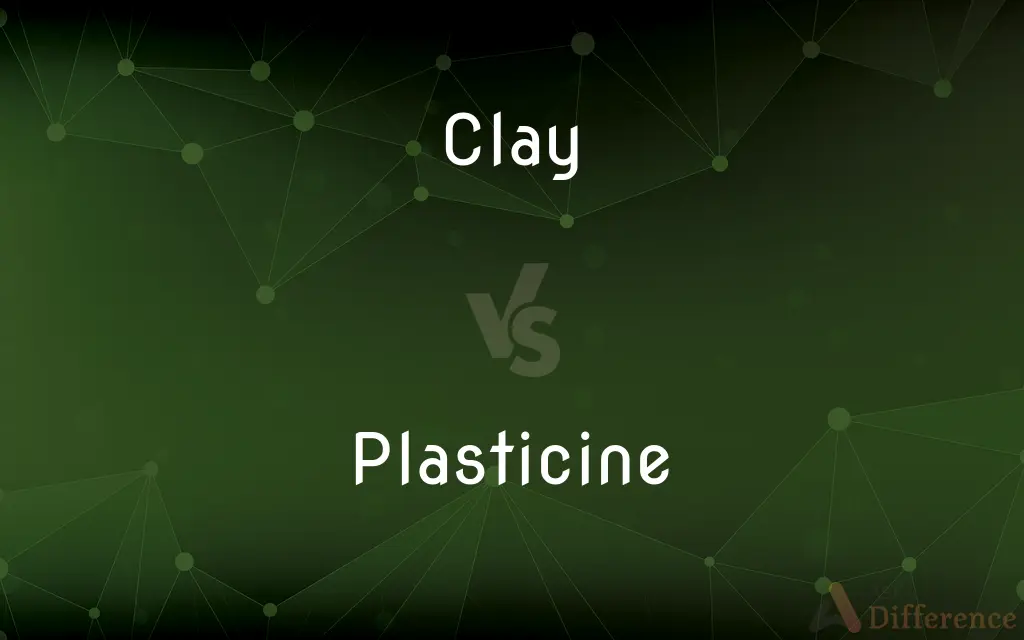Clay vs. Plasticine — What's the Difference?
By Tayyaba Rehman & Maham Liaqat — Updated on April 3, 2024
Clay is a natural, earthy material used in ceramics and sculpting, drying hard when fired, whereas plasticine is a synthetic, non-drying modeling material, remaining pliable and used primarily for art.

Difference Between Clay and Plasticine
Table of Contents
ADVERTISEMENT
Key Differences
Clay, sourced directly from the earth, is composed of minerals and water, offering a tactile experience that hardens when exposed to air and heat. This property makes it ideal for creating durable items like pottery and bricks. Whereas, plasticine, a synthetic compound, maintains its elasticity and malleability regardless of exposure to air or temperature, making it a favorite for temporary models and educational tools.
While clay requires kneading to become pliable and may require water to maintain its workability, plasticine is ready to use straight out of the package, with a consistency that remains uniform over time. This makes plasticine more user-friendly for beginners and children.
The process of working with clay often involves techniques like coiling, pinching, and slab building, and it necessitates a kiln for the final hardening process. On the other hand, plasticine can be shaped, cut, and blended without the need for any specialized equipment, offering a more accessible and less technical medium for creativity.
Clay, when fired, undergoes a permanent transformation, becoming waterproof and sturdy, which is why it's used for making crockery, tiles, and sculptures intended to last. Plasticine, however, cannot be fired or hardened, which restricts its use to drafts, models, or temporary art pieces.
The aesthetic qualities of objects made from clay can vary significantly based on the type of clay, firing techniques, and glazes used, giving each piece a unique finish. In contrast, plasticine comes in a wide range of colors, allowing for immediate vibrancy and color mixing but lacks the depth and texture that comes with fired clay artworks.
ADVERTISEMENT
Comparison Chart
Composition
Natural minerals and water
Synthetic materials
Durability
Hardens and becomes durable when fired
Remains soft and malleable indefinitely
Usage
Pottery, ceramics, permanent sculptures
Modelling, temporary sculptures, educational tools
Preparation
Requires kneading and sometimes water
Ready to use from the package
Final State
Can be waterproof and permanent
Cannot be hardened or made permanent
Compare with Definitions
Clay
A natural, earthy material used for making pottery.
She molded the clay into a beautiful vase.
Plasticine
Non-drying and can be reused multiple times.
After the presentation, the plasticine was stored for future use.
Clay
Requires firing at high temperatures to harden.
After shaping, the clay was fired in a kiln at 1200°C.
Plasticine
Not suitable for firing or permanent structures.
The sculpture must be recreated in clay for firing, as plasticine melts.
Clay
Found in various types, including earthenware, stoneware, and porcelain.
They chose stoneware clay for its durability and color.
Plasticine
A synthetic, malleable substance used for art and modeling.
The artist used plasticine to create a detailed model.
Clay
Prone to drying and cracking if not kept moist.
They kept the clay wrapped in damp cloth to prevent drying.
Plasticine
Ideal for children's crafts and education.
The teacher used plasticine for the playdough activity.
Clay
Can be glazed for aesthetic and functional purposes.
The clay mug was glazed to make it waterproof.
Plasticine
Comes in a variety of colors for immediate use.
She picked blue plasticine to model the sea.
Clay
Clay is a type of fine-grained natural soil material containing clay minerals. Clays develop plasticity when wet, due to a molecular film of water surrounding the clay particles, but become hard, brittle and non–plastic upon drying or firing.
Plasticine
Plasticine is a putty-like modelling material made from calcium salts, petroleum jelly and aliphatic acids. Plasticine is used for children's play and as a modelling medium for more formal or permanent structures.
Clay
A stiff, sticky fine-grained earth that can be moulded when wet, and is dried and baked to make bricks, pottery, and ceramics
A clay soil
A clay tile
The soil is mainly clay
The rocks are covered by various mixtures of loose clays and sands
Plasticine
A soft modelling material, used especially by children
I made a snake by rolling out plasticine
Plasticine creatures
Clay
A European moth with yellowish-brown wings.
Plasticine
Modeling clay.
Clay
A fine-grained, firm earthy material that is plastic when wet and hardens when heated, consisting primarily of hydrated silicates of aluminum and widely used in making bricks, tiles, and pottery.
Plasticine
A synthetic material resembling clay but remaining soft; used as a substitute for clay or wax in modeling (especially in schools)
Clay
A hardening or nonhardening material having a consistency similar to clay and used for modeling.
Clay
(Geology) A sedimentary material with grains smaller than 0.002 millimeter in diameter.
Clay
Moist sticky earth; mud.
Clay
The human body as opposed to the spirit.
Clay
A mineral substance made up of small crystals of silica and alumina, that is ductile when moist; the material of pre-fired ceramics.
Clay
An earth material with ductile qualities.
Clay
(tennis) A tennis court surface made of crushed stone, brick, shale, or other unbound mineral aggregate.
The French Open is played on clay.
Clay
(biblical) The material of the human body.
Clay
(geology) A particle less than 3.9 microns in diameter, following the Wentworth scale.
Clay
A clay pipe for smoking tobacco.
Clay
A clay pigeon.
We went shooting clays at the weekend.
Clay
(informal) Land or territory of a country or other political region, especially when subject to territorial claims
Danzig is rightfully German clay.
Clay
(transitive) To add clay to, to spread clay onto.
Clay
To purify using clay.
Clay
A soft earth, which is plastic, or may be molded with the hands, consisting of hydrous silicate of aluminium. It is the result of the wearing down and decomposition, in part, of rocks containing aluminous minerals, as granite. Lime, magnesia, oxide of iron, and other ingredients, are often present as impurities.
Clay
Earth in general, as representing the elementary particles of the human body; hence, the human body as formed from such particles.
I also am formed out of the clay.
The earth is covered thick with other clay,Which her own clay shall cover.
Clay
To cover or manure with clay.
Clay
To clarify by filtering through clay, as sugar.
Clay
A very fine-grained soil that is plastic when moist but hard when fired
Clay
Water soaked soil; soft wet earth
Clay
United States general who commanded United States forces in Europe from 1945 to 1949 and who oversaw the Berlin airlift (1897-1978)
Clay
United States politician responsible for the Missouri Compromise between free and slave states (1777-1852)
Clay
The dead body of a human being
Common Curiosities
What is the primary difference between clay and plasticine?
Clay is a natural material that hardens when dried and fired, while plasticine is a synthetic, non-drying modeling substance.
Can clay be reused like plasticine?
Once clay has been dried or fired, it cannot be reused; however, unused clay can be rehydrated and used again.
Do both clay and plasticine require special tools for modeling?
While both can be modeled by hand, clay often requires specific tools for fine details and preparing for firing, unlike plasticine.
Is plasticine a good choice for outdoor sculptures?
No, plasticine is not durable or weather-resistant, making it unsuitable for outdoor sculptures.
Is it possible to paint on clay and plasticine?
Clay can be painted, especially after firing and glazing. Painting on plasticine is not recommended due to its oily surface.
What makes clay suitable for ceramic production?
Its ability to be molded, dried, and fired into a durable material makes clay ideal for ceramics.
Can clay and plasticine be used interchangeably?
No, they serve different purposes; clay is used for permanent creations requiring firing, while plasticine is for temporary models and educational tools.
Can the colors of plasticine be mixed to create new colors?
Yes, plasticine colors can be blended to create new shades and variations.
Is plasticine suitable for making pottery?
No, plasticine cannot be fired or hardened, making it unsuitable for pottery.
Are there different types of clay?
Yes, there are several types of clay, including earthenware, stoneware, and porcelain, each with different properties and uses.
Can plasticine be hardened by any method?
Plasticine is designed to remain pliable and cannot be hardened by heat or other means.
Can both clay and plasticine be used for educational purposes?
Yes, both are used in education for different purposes: clay for art education and pottery, and plasticine for early childhood development activities.
Why is plasticine favored for temporary modeling?
Its non-drying nature and ease of use make plasticine ideal for temporary models and drafts.
How does the environmental impact of clay compare to plasticine?
Clay, being natural, has a lower environmental impact compared to synthetic, petroleum-based plasticine.
How are clay and plasticine packaged and sold?
Clay is typically sold in blocks or wedges, often requiring preparation before use. Plasticine is sold ready to use, often in multiple colors.
Share Your Discovery

Previous Comparison
Pull vs. Sway
Next Comparison
Hypothesised vs. HypothesizedAuthor Spotlight
Written by
Tayyaba RehmanTayyaba Rehman is a distinguished writer, currently serving as a primary contributor to askdifference.com. As a researcher in semantics and etymology, Tayyaba's passion for the complexity of languages and their distinctions has found a perfect home on the platform. Tayyaba delves into the intricacies of language, distinguishing between commonly confused words and phrases, thereby providing clarity for readers worldwide.
Co-written by
Maham Liaqat













































